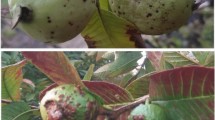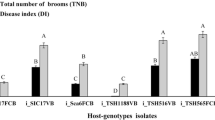Abstract
In this study, Neofusicoccum mediterraneum, a highly aggressive plant pathogen with a broad host range, including Eucalyptus spp., was investigated to determine its optimum medium and temperature for mycelial growth and chlamydospore production. The results revealed differences in the growth behaviour of N. mediterraneum under different in vitro conditions. Potato Sucrose Agar (PSA) was determined to be the most favourable environment for mycelial growth, achieving the maximum growth rate (GR) of 100% after 3 days of incubation at 25 °C. This was closely followed by cultures on Malt Extract Agar (MEA), exhibiting a GR of 100% after 4 days of incubation at 25 °C, while both substrates displayed optimal growth within the temperature range of 25 to 30 °C. The General Linear Model (GLM) unveiled significant differences in the growth rate across the different media (P = 0.000) and temperatures (P = 0.000). The interaction effect (media*temperature) retained its high significance throughout all incubation days (P < 0.0001). The binomial distribution and multinomial logistic regression analysis revealed that colony texture was significantly influenced by both the media (P = 0.022) and the temperature (P = 0.008). Additionally, temperature affected significantly the surface colour (P = 0.015) and reverse colour (P = 0.023) of the colony. Production of chlamydospores was observed only on PSA at 20 °C, 25 °C, 30 °C and 35 °C and on PDA at 25 °C and 30 °C. Both the medium and temperature had notable influences on the pathogen's growth, highlighting their importance in understanding its biology and behaviour. These findings contribute to the understanding of the phenotypic plasticity exhibited by N. mediterraneum towards temperatures and growth substrates.


Similar content being viewed by others
References
Ababutain, I. M. (2013). Effect of some ecological factors on the growth of Aspergillus niger and Cladosporium sphaerospermum. American Journal of Applied Sciences, 10(2), 159–163.
Abouzakhar, F.A., Yangui, I., Messaoud, C., & Ben Jamâa M.L. (2022). Eucalyptus leaf diseases associated with Neofusicoccum spp. in North Africa. Journal of Arid Environments, 197, 104662.
Abu Bakar, N., Karsani, S. A., & Alias, S. A. (2020). Fungal survival under temperature stress: A proteomic perspective. Peer J, 8, e10423. https://doi.org/10.7717/peerj.10423
Adan, O.C.G., Huinink, H.P., & Bekker, M. (2011). Water relations of fungi in indoor environments. In: Adan, O.C.G., Samson, R.A. (eds) Fundamentals of mold growth in indoor environments and strategies for healthy living. Wageningen Academic Publishers, Wageningen. https://doi.org/10.3920/978-90-8686-722-6_2
Agustí-Brisach, C., & Armengol, J. (2012). Effects of temperature, pH and water potential on mycelial growth, sporulation and chlamydospore production in culture of Cylindrocarpon spp. associated with black foot of grapevines. Phytopathologia Mediterranea, 51, 37–50.
Al-Muzaffar, H.A., & Muhammad, B.T. (2013). The influence of some environmental factors on the growth fungi Sclerotinia sclerotiorum and production of stone bodies. The second scientific conference of the College of Education for Pure Sciences, University of Baghdad.
Carlile, M. J., Watkinson, S. C., & Gooday, G. W. (2001). The Fungi. Academic press.
Ciliberti, N., Fermaud, M., Roudet, J., & Rossi, V. (2015). Environmental conditions affect Botrytis cinerea infection of mature grape berries more than the strain or transposon genotype. Phytopathology, 105, 1090–1096.
Crous, P. W. (2002). Taxonomy and pathology of Cylindrocladium (Calonectria) and allied genera (p. 294). APS Press.
De Ligne, L., Vidal-Diez de Ulzurrun, G., Baetens, J.M., Van den Bulcke, J., Van Acker, J., & De Baets, B. (2019). Analysis of spatio-temporal fungal growth dynamics under different environmental conditions. IMA Fungus, 10 (7).
Espinoza, J. G., Briceño, E. X., Chávez, E. R., Úrbez-Torres, J. R., & Latorre, B. A. (2009). Neofusicoccum spp. associated with stem canker and dieback of blueberry in Chile. Plant Disease, 93, 1187–1194.
Feng, S., Shu, C., Wang, C., Jiang, S., & Zhou, E. (2017). Survival of Rhizoctonia solani AG-1 IA, the causal agent of rice sheath blight under different environmental conditions. Journal of Phytopathology, 165, 44–52.
Garrett, A. T. A., Santos, A. F., Figueiredo Filho, A., Tambarussi, E. V., Gonçalves, A. B., & Garcia, F. A. O. (2019). Mycelial growth and sporulation of Apoharknessia eucalyptorum on different culture media. Summa Phytopathologica, 45, 272–278.
Gauthier, G. M. (2015). Dimorphism in fungal pathogens of mammals, plants, and insects. PLoS Pathogens, 1, e1004608.
Gock, M. A., Hocking, A. D., Pitt, J. I., & Poulos, P. G. (2003). Influence of temperature, water activity and pH on growth of some xerophilic fungi. International Journal of Food Microbiology, 2481, 11–19.
Grosch, R., & Kofoet, A. (2003). Influence of temperature pH and inoculum density on bottom rot on lettuce caused by Rhizoctonia solani. Journal of Plant Diseases and Protection, 110, 366–378.
Halleen, F., Fourie, P. H., & Crous, P. W. (2006). A review of black foot disease of grapevine. Phytopathologia Mediterranea, 45, 55–67.
Halleen, F., Schroers, H. J., Groenewald, J. Z., & Crous, P. W. (2004). Novel species of Cylindrocarpon (Neonectria) and Campylocarpon gen. nov. associated with black foot disease of grapevines (Vitis spp.). Studies in Mycology, 50, 431–455.
Hubballi, M., Nakkeeran, S., Raguchander, T., Anand, T., & Samiyappan, R. (2010). Effect of Environmental conditions on growth of Alternaria alternata causing leaf blight of Noni. World Journal of Agricultural Sciences, 6(2), 171–177.
Huang, S.L., Yang, D., Zheng, X.L., Li, P., Ayra-Pardo, C., Wang, L., Xu, D.Y., Fu, G., & Du, C.J. (2020). First report of Neofusicoccum parvum causing brown spot disease on glossy privet in China. Plant disease, 104(10). https://doi.org/10.1094/PDIS-02-22-0299-PDN
Jami, F., Slippers, B., Wingfield, M. J., Loots, M. T., & Gryzenhout, M. (2015). Temporal and spatial variation of Botryosphaeriaceae associated with Acacia karroo in South Africa. Fungal Ecology, 15, 51–62.
Jia, Z., Zhang, X., & Cao, X. (2009). Effects of carbon sources on fungal morphology and lovastatin biosynthesis by submerged cultivation of Aspergillus terreus. Asia-Pacific Journal of Chemical Engineering, 4, 672–677.
Kunert, J. (2000). Physiology of keratinophilic fungi. Revista Iberoamericana De Micología, 1, 77–85.
Kurbanoglu, E. B., & Algur, Ö. F. (2002). Use of Ram Horn Hydrolyste as a peptone for bacterial growth. Turkish Journal of Biology, 26, 115–123.
Kwon-Chung, K.S., & Bennett, E. (1992). Medical Mycology. Williams and Wilkins, 2nd ed.USA.
Lazzizera, C., Frisullo, S., Alves, A., & Phillips, A. J. L. (2008). Morphology, phylogeny and pathogenicity of Botryosphaeria and Neofusicoccum species associated with drupe rot of olives in southern Italy. Plant Pathology, 57, 948–956.
Li, G., Slippers, B., Wingfield, M. J., & Chen, S. (2020). Variation in Botryosphaeriaceae from Eucalyptus plantations in YunNan Province in southwestern China across a climatic gradient. IMA Fungus, 11(22), 1–49.
Moni, Z. R., Ali, M. A., Alam, M. S., Rahman, M. A., Bhuiyan, M. R., Mian, M. S., Iftekharuddaula, K. M., Latif, M. A., & Khan, M. A. I. (2016). Morphological and Genetical Variability among Rhizoctonia solani Isolates Causing Sheath Blight Disease of Rice. Rice Science, 23(1), 42–50.
Nemecek, J. C., Wüthrich, M., & Klein, B. S. (2006). Global Control of Dimorphism and Virulence in Fungi. Science, 312, 583–588.
Pasanen, A. L., Kalliokoski, P., Pasanen, P., Jantunen, M. J., & Nevalainen, A. (1991). Laboratory studies on the relationship between fungal growth and atmospheric temperature and humidity. Environment International, 17, 225–228.
Safavi, S. A., Farooq, A. S., Aziz, K. P., Reza, R. G., Ali, R. B., & Tariq, M. B. (2007). Effect of nutrition on growth and virulence of the entamopathogenic fungus Beauvena bacissiana. FEMS Microbiology Letters, 270(1), 116–123.
Santini, A., & Ghelardini, L. (2015). Plant pathogen evolution and climate change. CABI Reviews, 35(10), 1–8
Tao, Y., Zeng, F., Ho, H., Wei, J., Wu, Y., Yang, L., & He, Y. (2011). Pythium vexans causing stem rot of Dendrobium in Yunnan Province China. Journal of Phytopathology, 159, 255–259.
Wang, B., Li, B. H., Dong, X. L., Wang, C. X., & Zhang, Z. F. (2015). Effects of Temperature, Wetness Duration, and Moisture on the Conidial Germination, Infection, and Disease Incubation Period of Glomerella cingulata. Plant Disease, 99, 176–293.
Wyss, G. S., Charudattan, R., & DeValerio, J. T. (2001). Evaluation of Agar and Grain Media for Mass Production of Conidia of Dactylaria higginsii. Plant Disease, 85, 1165–1170.
Yangui, I., Zouaoui Boutiti, M., Vettraino, A. M., Bruni, N., Vannini, A., Ben Jamaâ, M. L., Boussaid, M., & Messaoud, C. (2019). Biscogniauxia mediterranea (De Not.) O. Kuntze as a pathogen fungus associated with cork oak (Quercus suber L.) in Tunisia: Relationships between phenotypic variation, genetic diversity and ecological factors. Fungal Ecology, 41, 224–233.
Zhang, J., & Mc Donald, B. (2011). Thermal adaptation in the fungal pathogen Mycosphaerella graminicola. Molecular Ecology, 20, 1689–1701.
Zhao, H., Huang, L., Xiao, C. L., Liu, J., Wei, J., & Gao, X. (2010). Influence of culture media and environmental factors on mycelial growth and conidial production of Diplocarpon mali. Letters in Applied Microbiology, 50(6), 639–644.
Author information
Authors and Affiliations
Corresponding author
Ethics declarations
Ethics
This article did not contain any studies with human participants or animals performed by any of the authors.
Conflict of interest
The authors declare that they have no conflicts of interest.
Rights and permissions
Springer Nature or its licensor (e.g. a society or other partner) holds exclusive rights to this article under a publishing agreement with the author(s) or other rightsholder(s); author self-archiving of the accepted manuscript version of this article is solely governed by the terms of such publishing agreement and applicable law.
About this article
Cite this article
Abouzkhar, F.A., Yangui, I., Hlaiem, S. et al. Culture media and temperature effects on Neofusicoccum mediterraneum: assessing mycelial growth and colony characteristics. Eur J Plant Pathol (2023). https://doi.org/10.1007/s10658-023-02806-9
Accepted:
Published:
DOI: https://doi.org/10.1007/s10658-023-02806-9




